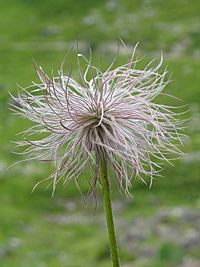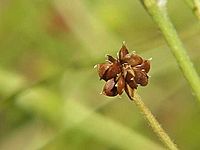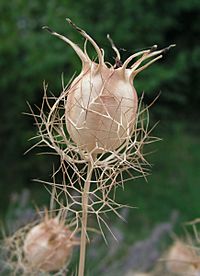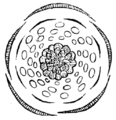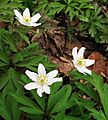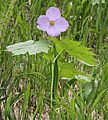Ranunculaceae facts for kids
The Ranunculaceae family is also known as the buttercup or crowfoot family. The name Ranunculus comes from Latin words meaning "little frog." This might be because many buttercup plants grow near water.
This plant family includes over 2,000 different types of flowering plants. They are grouped into 43 main categories, called genera. You can find these plants all over the world.
Some of the biggest groups in this family are:
- Ranunculus (with 600 species)
- Delphinium (365 species)
- Thalictrum (330 species)
- Clematis (325 species)
- Aconitum (300 species)
Quick facts for kids Ranunculaceae |
|
|---|---|
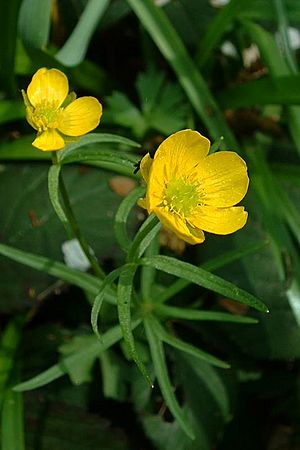 |
|
| Ranunculus auricomus | |
| Scientific classification | |
| Type genus | |
| Ranunculus |
|
| Subfamilies | |
|
Contents
Plant Characteristics
Most plants in the Ranunculaceae family are herbaceous. This means they have soft, green stems that do not become woody. They can be:
- Annuals: Plants that live for only one growing season.
- Perennials: Plants that live for more than two years.
However, some plants in this family are different. For example, Clematis plants are woody climbers. Xanthorhiza plants are shrubs, which are woody plants smaller than trees.
Flowers and Symmetry
Most flowers in this family have both male and female parts. This means they are bisexual flowers. They can be very colorful and easy to see, or sometimes they are small and hidden.
Flowers can grow alone, or they can grow in groups. These groups are called inflorescences. They can look like:
- Cymes (flat-topped clusters)
- Panicles (loose, branching clusters)
- Spikes (flowers directly attached to a central stem)
Many flowers in this family have radially symmetrical flowers. This means they look the same if you cut them in half in any direction, like a pizza. But some, like Aconitum and Delphinium, are bilaterally symmetrical. This means they only look the same if you cut them in half in one specific way, like a human face.
The parts of the flower, like the sepals, petals, stamens (male parts), and carpels (female parts), are usually separate. They are not joined together. There are typically four or five outer flower parts.
Some outer stamens might change to produce only nectar. Nectar is a sweet liquid that attracts insects. You can see this in plants like Helleborus and Delphinium. In other plants, like Thalictrum, the sepals are bright and look like petals, while the actual petals might be small or missing.
Stems and Leaves
The stems of these plants do not have thorns or prickles. The leaves can look very different from one species to another. Most plants have leaves that grow from the base of the plant and also along the stem. These leaves are often divided into smaller parts or have deep cuts. They usually grow one after another along the stem. Sometimes, they grow opposite each other or in a circle.
Many perennial species grow rhizomes. These are underground stems that grow new roots each year. The plant Ficaria verna can grow new plants from small root tubers. These tubers grow where the leaves meet the stem.
Pollination
Some plants in the Thalictrum group use anemophily for pollination. This means their pollen is carried by the wind. Other plants use entomophily, which means insects carry their pollen. Flowers of the Papaver group, which is also related, only produce pollen, not nectar.
Fruits
The fruits of Ranunculaceae plants are usually separate and not joined together. They are most often:
- Achenes: Small, dry fruits that contain one seed, like in Ranunculus and Clematis.
- follicles: Dry fruits that split open along one side to release seeds, like in Helleborus, Eranthis, and Nigella.
However, some plants, like Actaea, produce a berry.
Safety Information
Ranunculaceae plants contain a substance called protoanemonin. This substance can be toxic to humans and animals. Other poisonous compounds, like alkaloids and glycosides, are also often found in these plants.
Images for kids
-
Helleboreae: Helleborus × hybridus
-
Caltheae: Caltha palustris
-
Anemoneae: Anemone nemorosa
-
Hydrastidoideae: Hydrastis canadensis
See also
 In Spanish: Ranunculáceas para niños
In Spanish: Ranunculáceas para niños


